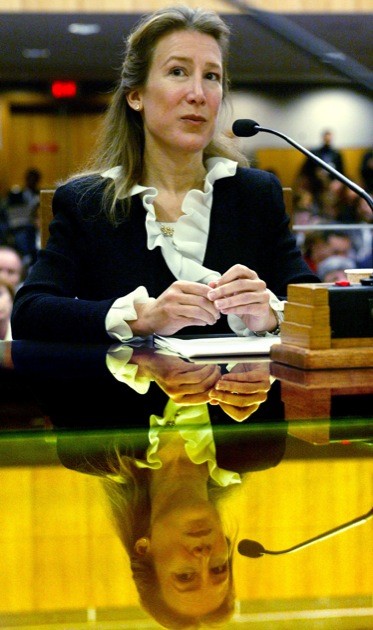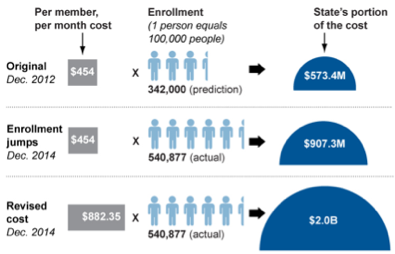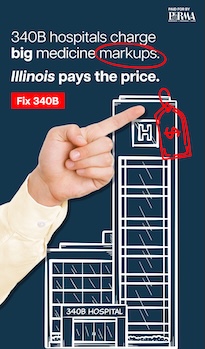Question of the day
Friday, Feb 6, 2015 - Posted by Rich Miller
* Gov. Bruce Rauner’s administration has just contracted with his new CFO Donna Arduin’s consulting firm for $30,000 a month…
Sole Source Only Justification: The Governor’s Office of Management and Budget is giving notice of its intent to enter into a sole economically feasible source contract with Arduin Associates, Inc. to provide consulting services for continued implementation and necessary adjustment of the State’s 2015 budget to assist in preparing the State’s 2016 budget.
Total Amount of Award: $120,000.00
Length of Initial Term: 4 [months]
Contract Begin Date: 02/02/2015
Contract End Date: 05/31/2015
* Ms. Arduin…

* The Question: Caption?
186 Comments  
|
* Remember this Tribune story from the other day?…
Starting in 2017, Illinois and other states that also expanded their programs are required to start paying a small portion of the bill, rising to no more than 10 percent of the total tab. State health officials estimated in 2012 that Illinois’ portion of the expansion would cost $573 million from 2017 through 2020.
But far more people signed up in 2014, the expansion’s first year, than the state expected. Based on multiple interviews and a Tribune analysis of government data, Illinois will pay at least $907 million from 2017 through 2020 because of those new members. The tab could surge even higher, though.
A document sent by Quinn’s office to the federal government over the summer significantly raised the per-person estimated cost, bumping the state’s total outlay to $2 billion, using 2014 enrollment numbers, more than three times the original estimate.
* The story was accompanied by this startling graph…

The $882 figure was from a June, 2014 waiver proposal drafted by Gov. Quinn’s office, not the Department of Healthcare and Family Services. That’s crucial to what we’ll get to in a moment.
* The Tribune editorial board thundered from on high…
Two years from now, when Illinois taxpayers start covering a portion of the expansion costs, they’ll be paying far more than the $573 million they were told they’d have to pay from 2017 through 2020. The real cost will be at least $907 million. And a document sent to the federal government last summer by the office of then-Gov. Pat Quinn said that number could swell to $2 billion.
Chalk it up as one more failure of past management that Gov. Bruce Rauner faces Wednesday as he delivers his State of the State address.
* But can those numbers really be correct? Are we looking at almost doubling the per member, per month cost? I reached out to Samantha Olds Frey. Samantha probably knows more about Illinois’ Medicaid program than anyone alive. From her bio…
Samantha Olds is the Executive Director of the Illinois Association of Medicaid Health Plans. Prior to joining the association, Samantha was Speaker Michael J. Madigan’s Human Services & Medicaid budget analyst. During her tenure on the Speaker’s staff, Samantha helped negotiate and craft the Medicaid Reform Act of 2010, the $2.7 billion Medicaid reform package known as the SMART Act of 2012, and the Medicaid Expansion package authorized by the Affordable Care Act in 2013.
The Illinois Association of Medicaid Health Plans represents pretty much all insurers.
* Sam and I talked the other day and she sent me a rebuttal to the Tribune the next morning. I asked her to flesh it out a little more and she sent me this today…
Good Afternoon Rich,
I feel like I am saying the same thing over and over again. Simply that the $882 was not a real number and that the cost is significantly lower than that. I can try to explain more if you would like. It is just that there are a lot of Medicaid experts that I have spoken with and no one has quite been able to get to that high of a cost. We truly do believe it was a number created for negotiation purposes. It was also a projection and not based off of actual costs. In other words, the $882 was the ceiling of what could happen. However, we now have data and are seeing that what actually did happen was that ACA adults cost roughly $300 or less per month. (To put this in context, my exchange plan costs $333 and offers fewer benefits than the Medicaid program.)
1) The estimated cost of $454 to $882 does not in anyway reflect the true costs of Medicaid PMPM [per member, per month] nor does it reflect the cost of ACA individuals. The $882 amount was created by the Governor’s office and not HFS. At this point it is unclear what went into developing the $882. All we know is that in no way shape or form is it tracking with the true cost of the program. I am not a waiver expert, but it is my understanding that in the process of negotiating a waiver the state puts forth as high of costs as possible for the purpose of having a strong starting point. I am also aware that the Chicago Tribune was well aware that the $882 was not reflective of what HFS is seeing as the true cost of ACA adults.
2) I have attached 2 documents that will better reflect that cost. The first is a spreadsheet that tracks the cost of Medicaid since FY03. The other demonstrates what health plans are paid to serve the ACA population. When you look at the averages you see that we are right around $300 per member per month. It is also important to note that this is an average of averages. We have members that cost $100 and disabled seniors that cost thousands.
It is my understanding that the cost of an ACA adult will be roughly $300 per member per month. In fact, HFS is tracking a cost of roughly $230 per member per month right now. However, as the year goes on it is normal to see the later months have a higher cost than the earlier months. Due to this naturally occurring process I suspect we will see a cost of $300 per member per month or slightly lower by the end of the fiscal year. This is 1/3rd the cost of the Tribune’s projections.
3) The $882 was used to put the state in a good position to negotiate with the federal government. It included everything and the kitchen sink in order to draw in more federal resources for the program. It is my understanding that this is normal in negotiations on both the public and private side.
To put it simply, the $882 is not reflective of the cost of the program and it is my understanding that the Department explained this to the Tribune. Medicaid Managed Care Organizations and HFS believe that the average cost of a newly eligible or ACA adult is $300 or less per member per month.
As always, thank you for all that you do and let me know if I can provide any more information.
Warmest regards,
Samantha Olds Frey
Emphasis added to show that, according to Olds Frey, the cost is only about a third of the projected per member per month costs claimed in the Tribune story.
* And as far as the Tribune’s earlier praise for Indiana’s Medicaid cost sharing ideas? Well, Olds Frey had this to say…
Cost sharing for Medicaid clients actually costs the state money. The administrative costs of collecting co-pays and premiums is incredibly high. This is especially true in the Medicaid program when you have union workers spending hours to collect a $20 premium.
Cost sharing for Medicaid clients decreases the quality of care. There is evidence all over the place that shows even a simple $2 co-pay decreases the likelihood of a Medicaid client seeking preventative care. Clearly a copay does not keep a client from getting sick though. Further evidence of this is that most Medicaid MCOs have eliminated copays because they want their clients to seek preventative care out as soon as possible.
28 Comments  
|
Soft landing for some Quinnsters
Friday, Feb 6, 2015 - Posted by Rich Miller
* Greg Hinz reports on some former Quinn administration PR types…
Abdon Pallasch, who was a deputy budget director, now is the new communications director for Cook County Sheriff Tom Dart.
The Illinois Department of Revenue’s Sue Hofer and health care spokesman Mike Claffey are at City Hall. She’s the new spokesman for Mayor Rahm Emanuel’s budget office, he’s at the Department of Transportation.
Katie Hickey has gone to work for City Treasurer Kurt Summers.
42 Comments  
|
More bad news for Schock
Friday, Feb 6, 2015 - Posted by Rich Miller
* As if Congressman Aaron Schock doesn’t have enough problems this week. He may have to move soon. From Peoria Public Radio…
Congressman Aaron Schock’s legally-documented residence in the 18th District is listed for sale as a foreclosure.
The congressman’s home address is listed as 222 W. Detweiller Drive on his Federal Election Commission filing dated Tuesday. But a foreclosure listing has been up for more than a week, and the 35 photos posted of the property show what appears to be a vacant home.
The person listed as the last owner is William Boyd.
The five bedroom, six bath home is listed for $2.3 million. The 7,236 square feet of living space is listed as a single family residence, but it’s believed the Congressman has been renting a carriage house portion of the property not registered as a stand alone address.
…Adding… From a PPR reporter…
An update to our story: Congressman Schock says he is still renting the carriage house on the property, only now he pays rent to the bank rather than the previous owner.
* Meanwhile, a lefty blogger put a whole lot of nasty red herrings into his story, but the gist is that a couple of years ago Schock allegedly sold a house to a Cat exec who had contributed a few bucks to Schock’s campaign. The contention is that Schock allegedly sold the place for more than it may have been worth…
Congressman Schock on October 16, 2012 sold his home to the Bahajs for $925,000… Zillow estimates that the house was worth approximately $695,000 that month.
Zillow ain’t always accurate. Just sayin…
I’m not sure at all about that blog piece, campers. I see some real problems with it, including the blogger’s bizarre vitriol. But I figured some of you would post it in comments because it’s being linked all over the place and some have already e-mailed me about it, so I wanted to head you off. Let that one be for now.
41 Comments  
|
Doing the budget dance
Friday, Feb 6, 2015 - Posted by Rich Miller
* The state’s $300 million shortfall for child care programs took on a human face yesterday during a Senate hearing…
Chandra Ankoor is a 24-year-old single mother from Springfield. While she is working, she sends her three daughters to child care that is partially paid for with the help of the state.
If it weren’t for this assistance, she says it would cost her every dollar she makes, and then some, to afford the cost of child care.
“I will have to look at three little girls’ faces and tell them that there’s no where else for them to go. And I’m facing going from working three or four jobs to possibly being homeless,” Ankoor said.
* So, what to do? An outline from the AP...
Representatives from the governor’s office said Rauner wants lawmakers to grant him wider authority than he currently has to maintain underfunded portions of the budget by reallocating money from other areas that aren’t “critical priorities.” Rauner’s budget director Tim Nuding said the governor’s office wanted the flexibility to address all problems in the current year’s budget.
“We don’t have the … authority to spend another dime until the legislature gives us the authority to do it,” Nuding said. […]
The idea is proving unpopular with some members of the Democratic-run General Assembly, who are concerned about which areas Rauner might cut to reallocate funding elsewhere. They’re also accusing the Winnetka Republican of using some programs, such as subsidized day care, as pawns as he tries to pressure Democrats to give him the broader authority he wants. Rauner has pledged to manage the state’s budget crisis without raising taxes.
* More on the scope of Rauner’s original request…
“It is very broad, what has been put on the table and asked for, very unusual. We have done emergency budget acts before to give flexibility to previous governors (but) nothing in the terms of what has been requested,” said state Sen. Heather Steans, a Chicago Democrat and chairwoman of a Senate budget panel.
* Even so…
House Speaker Michael Madigan, D-Chicago, on Wednesday noted that it would not be unprecedented to give Rauner that authority.
“Prior governors received extraordinary authority from the legislature — (Govs. Jim) Thompson and (Jim) Edgar — in the short term to reduce spending and reduce the level of appropriation,” Madigan said. “I’d be open to those ideas.”
Likewise, Senate President John Cullerton, D-Chicago, said the legislature took similar action during the 1992, 2010 and 2011 budget years.
“Gov. Rauner has asked legislative leadership to work with him on legislation to address the projected $1.5 billion gap in the current fiscal year state budget,” Cullerton said.
He added that the administration is “refining” its request for additional powers.
* Meanwhile…
Republicans said the child care program is just one of many shortfalls they expect to see from the budget mess and Rauner wants the ability to address those programs, too.
State Sen. Chapin Rose, R-Mahomet, said rehabilitation service programs are underfunded and looking for help.
State Sen. Tim Bivins, a Republican from Dixon, said court reporters are also underfunded and could be out of cash by March, creating problems in the court system.
And then, of course, the coming payroll crisis at the state’s prisons.
* WUIS on the governor’s negotiating posture…
Rauner’s people told the committee that keeping the child care program afloat is his top priority, but they warned that it is not the only thing in trouble. “This will not be the last crisis that comes before this committee in FY 15,” Nuding said. He said that the Department of Corrections could be unable to make payroll at some prisons in March or April.
Goldberg and Nuding would not commit to supporting standalone funding for the day care program if a deal cannot be struck on getting their boss control over the budget. And why would they? If they agree to fund programs near and dear to Democrats even if Rauner doesn’t get what he wants, then what leverage will he have in negotiations? That may seem callous, but it is how budgeting often works.
Rauner stands the chance to gain control over the current budget before he even presents his ideas for next fiscal year. From a purely operational perspective, he would be able to move money around and possibly tap special funds to patch the current deeply flawed budget and keep state government going. He would also be able to begin shaping the budget, albeit in limited ways, to his agenda almost immediately. On this issue and the budgeting process at large, one has to wonder if Rauner may be thinking of a quote from his friend Chicago Mayor Rahm Emanuel (which is a riff on a quote from Winston Churchill): “You never let a serious crisis go to waste. And what I mean by that — it’s an opportunity to do things you think you could not do before.”
Agreed.
43 Comments  
|
* Sun-Times…
The Illinois Senate on Thursday passed an increase in the state’s minimum wage to $11 by 2019, one day after Gov. Bruce Rauner used his State of the State speech to pitch a lower, more gradual increase.
The bill by Sen. Kimberly Lightford, D-Maywood, passed 35-18 and now moves to the House. It increases the minimum wage from $8.25 to $9 by July 1. The wage would then increase by 50 cents every year until it reaches the $11 ceiling. It also includes a tax credit for businesses with fewer than 50 employees. .
* The Tribune claimed the vote could be merely a symbolic gesture…
Senate Republicans criticized the move, saying it was a slight to a governor who indicated he wanted to work with Democrats to raise the wage during his tenure. Rauner says any increase in the wage should be packaged with business-friendly measures such as an overhaul in the workers’ compensation system and limits to lawsuits.
“I would just ask that you take the governor on his word that this is something he is going to deal with, and then we can continue the conversation,” said Sen. Kyle McCarter, R-Lebanon.
Support for an increase remains questionable in the House, where a similar measure stalled last fall. Speaker Michael Madigan, D-Chicago, said he supports the effort and is working to gather votes.
* Some in the business community, however, are pointing to a San Francisco bookstore whose owner supported the living wage concept that is now going out of business. From a letter to its customers…
In November, San Francisco voters overwhelmingly passed a measure that will increase the minimum wage within the city to $15 per hour by 2018. Although all of us at Borderlands support the concept of a living wage in principal and we believe that it’s possible that the new law will be good for San Francisco — Borderlands Books as it exists is not a financially viable business if subject to that minimum wage. Consequently we will be closing our doors no later than March 31st. The cafe will continue to operate until at least the end of this year.
Many businesses can make adjustments to allow for increased wages. The cafe side of Borderlands, for example, should have no difficulty at all. Viability is simply a matter of increasing prices. And, since all the other cafes in the city will be under the same pressure, all the prices will float upwards. But books are a special case because the price is set by the publisher and printed on the book. Furthermore, for years part of the challenge for brick-and-mortar bookstores is that companies like Amazon.com have made it difficult to get people to pay retail prices. So it is inconceivable to adjust our prices upwards to cover increased wages.
The change in minimum wage will mean our payroll will increase roughly 39%. That increase will in turn bring up our total operating expenses by 18%. To make up for that expense, we would need to increase our sales by a minimum of 20%. We do not believe that is a realistic possibility for a bookstore in San Francisco at this time.
$11 an hour ain’t $15 an hour, but you get the drift.
23 Comments  
|
Strong finance showing for Kirk
Friday, Feb 6, 2015 - Posted by Rich Miller
* Sen. Mark Kirk had a very good fourth quarter…
Kirk raised $621,998 in the quarter that ended Dec. 31, more than twice what he pulled in during the third quarter and a sign that he is serious when he says he expects to run for re-election next year.
A copy of Kirk’s campaign disclosure form is not yet available, but a source familiar with it says it includes donations from 500 individuals and 120 political action committees and other groups. With the new money, the senator will have just over $2 million on hand in his campaign bank account.
Kirk certainly will have to raise a ton more. Insiders expect the 2016 race to cost well over $10 million, and perhaps twice that figure if he faces a top challenge in the GOP primary. But $2 million is certainly a nice place to be more than a year before anyone votes.
* He’s gonna need it and more. National Journal just released its poll of DC “insiders” and Kirk was rated as the second-most vulnerable Senator by both Democrats (26 percent, compared to 27 for Harry Reid) and Republicans (25 percent, compared to 42 for Reid). Comments by some of the Democratic insiders…
“Navy blue state, presidential year, Illinois native at the top of the Dem ticket. Good luck with that, Mark.”
“Illinois presidential turnout is going to make Kirk’s reelection really tough.”
“Recently embarrassed himself on climate change. If he continues to act like he shouldn’t be there, he won’t be.”
“If [Democratic Rep. Tammy] Duckworth runs, Kirk’s No. 1 out the door.”
From the Republicans…
“Illinois, presidential year, health concerns—doesn’t get much worse than that.”
I’m still not convinced that he’s a goner. Having a wealthy Republican governor adds a different dimension to state politics here. But if Rauner’s numbers tank, and Hillary does as well as expected here, and Kirk draws a strong opponent, then, yeah, he’s got his work cut out for him.
30 Comments  
|
Could this be one reason why?
Friday, Feb 6, 2015 - Posted by Rich Miller
* Gov. Bruce Rauner as quoted by WAWV TV, in Indiana’s Wabash Valley, just across the border from Marshall, IL…
“We’ve been cutting school funding in Illinois for a long time. We’re number 50 out of 50 states,” he said. “We’re dead last on state support for education. That’s wrong and I want to change it.”
I believe he’s referring to here is state support as a percentage of all education spending, including local spending. We’ve been at or near the bottom of that ranking for decades.
That’s kind of a misleading figure because just about all states require local school districts to pick up the full employer pension payment. Illinois picks up that tab, but doesn’t count it as part of its support for schools, which is odd.
* Anyway…
Republican Gov. Bruce Rauner’s call for a two-year freeze on property taxes stems from a a simple truth: Nobody wants to pay more of the most-hated tax of all.
The new governor’s populist proposal figures to be embraced by businesses and homeowners, who have long complained that their property taxes are too high and crave a respite from years of increases.
But local officials whose schools and government operations rely on property taxes worry how they will get by if Rauner’s proposal for a freeze goes through.
“Well, people will try to argue that,” Rauner said at a stop to discuss his initiatives in downstate Troy on Thursday. “But here’s the issue: Our property taxes are too high. We’ve got to bring them down.”
So, if he successfully manages to freeze local levies for two years, and manages to increase state spending on pre-K-12, then Illinois may move up that aforementioned ranking of state support as a percentage of all education spending.
Or maybe I’m reading too much into this.
Your thoughts?
34 Comments  
|
The long game on unions has come to Illinois
Friday, Feb 6, 2015 - Posted by Rich Miller
* The governor does have a clever retort…
After Gov. Bruce Rauner’s speech [in Mt. Vernon] on Thursday, where he called for improving the state’s business climate, several people began a loud chant, yelling in repetition “union buster” towards the governor as he exited.
During the brief speech inside the Holiday Inn, Rauner said people have been suggesting, based on recent policy statements, that he “hates unions.”
“I don’t hate unions,” he said. “Join a union. Don’t join a union. It’s all good with me.” […]
The governor said his grandfather was a “big union guy”, and he believes one “should be free to join one or not.”
“Why should you be forced to join a union?” he said. “Join if you want to. God bless you. That’s what America’s about – freedom to choose.”
* Indeed, the governor’s response has been poll-tested here by the Illinois Policy Institute…

The August, 2014 poll of 739 Illinoisans had a margin of error of ±3.6 percent.
And when you put it that way, of course people are gonna support the idea. Freedom to choose is, indeed, the American way. But that’s not what this issue is about. Instead, it’s about allowing people in union shops to get all the benefits of union representation without having to pay any dues to their representatives. And then, ultimately, to bankrupt the unions and drive down everyone’s wages.
* A 2013 article published by the Illinois Policy Institute’s site stresses the long-term nature of this fight, using Michigan’s success as an example of a hard-fought, decades-long battle…
An Olympic champion gets the gold by winning the race just before medals are handed out. But that doesn’t explain everything that put the right runner with the right training in the right race at the right moment. It takes tons of heart, gallons of sweat, hundreds of good decisions and many years. Similarly, Michigan’s story of Right to Work is one of endurance and persistence. […]
For Right to Work to move from impossible to inevitable in Illinois, reformers should focus first on the idea phase to create the environment for a future political phase. Starting with the political phase guarantees setbacks because lawmakers usually won’t stick their necks out for an idea the people won’t get behind. That’s why the Illinois Policy Institute is so critical. Like Mackinac, it understands the power of developing an idea in order to make it politically possible.
Not every impossible idea becomes reality, but strategies exist for transforming impossible ideas into reality. Illinois is becoming surrounded by states that are taking on unions to regain control of their fiscal destinies. Chances are it won’t take as long for the Illinois Policy Institute to make Illinois a Right-to-Work state as it took for Mackinac to win its victory.
151 Comments  
|
* From IEMA…
– Some of the largest earthquakes ever recorded in North America rocked the mostly rural Central U.S. between December 1811 and February 1812, including parts of southern Illinois. The strongest earthquakes in this series were estimated to be around magnitude 8.0, and were felt as far away as the East Coast.
Today, this multi-state region is heavily populated and highly developed. A similar earthquake now would cause widespread devastation to buildings, utilities, roads, bridges and other infrastructure, as well as result in many injuries and deaths. While damage would be less severe in other parts of Illinois, utility outages, road closures and disruptions to deliveries of essential supplies would significantly impact the lives of most Illinoisans.
Recognizing this serious risk, the Illinois Emergency Management Agency (IEMA) and local emergency management agencies will promote earthquake preparedness throughout February.
“Southern Illinois is adjacent to two earthquake zones, so the risk of a major earthquake is very real,” said IEMA Acting Director Joe Klinger. “We can’t predict when the next devastating earthquake will occur, but we can help people learn how to protect themselves and reduce damage to their homes.”
Klinger said people need to remember to “Drop, Cover and Hold On” when they feel the ground shaking. The phrase prompts people to “Drop” down to the floor, take “Cover” under a sturdy desk, table or other furniture, and “Hold On” to the furniture item and be prepared to move with it until the shaking ends.
There are several steps people can take to help prevent injuries and property damage at home, including:
• Strapping water heaters and large appliances to wall studs
• Anchoring overhead light fixtures
• Fastening shelves to wall studs and securing cabinet doors with latches
• Learning how to shut off gas, water and electricity in case the lines are damaged
* But folks up north have little to fear, according to the Tribune…
Seth Stein, a professor of geological sciences at Northwestern University, has written a book about the New Madrid zone disputing much of the talked-about widespread damage of the 19th century earthquakes that hit Illinois.
In Northern Illinois “the hazard is so small” for earthquakes that taking measures like strapping in large furniture is probably unnecessary, Stein said.
“If you were going to spend a dollar on a restraining strap, I’d buy a lottery ticket,” Stein said.
On the other hand, he said, folks in a place like Carbondale at the southern tip of the state may want to consider taking such steps. Even there, though, “the risk (of a substantial earthquake) is not huge.” […]
Stein says it’s unlikely an earthquake as strong as the ones in the 19th century could hit Illinois again in the next hundreds of years. Even if one did, Northern Illinois would likely face little, if any, damage, he said.
“The more you know about it, the less you worry about it,” Stein said.
11 Comments  
|
* From a press release…
Governor Bruce Rauner and U.S. Senator Mark Kirk (R-Ill.) [yesterday] released the following statement on the U.S. Department of Energy’s decision to end federal funding of FutureGen, the public-private clean coal project in Meredosia, Ill.:
“We are thoroughly disappointed in the Administration’s decision to hastily end the bipartisan FutureGen project. This decision will block advancements in clean coal and more than 1,000 new jobs in Central Illinois. We will not give up on this state-of-the-art technology and bringing new jobs to the state.”
* The administration’s explanation…
Spokesman Bill Gibbons with the federal agency told The Associated Press the department concluded the project couldn’t meet a September deadline to use its $1 billion in federal stimulus funding.
A spokesman for the FutureGen Alliance said the group has no choice but to shut down because it can’t finish the $1.65 billion project without federal funding.
* Another press release…
U.S. Reps. Rodney Davis (R-Ill.), John Shimkus (R-Ill.) and Aaron Schock (R-Ill.) [yesterday] expressed concern over the U.S. Department of Energy’s decision to end federal funding for FutureGen, a public-private project to retrofit a coal-fired power plant in Meredosia, Ill.
“This week’s announcement by the DOE to abandon FutureGen is another example of wasted stimulus funds and another failed attempt to create ’shovel-ready’ projects,” said Davis. “The administration has failed the people of Central Illinois by wasting hundreds of millions of dollars invested by taxpayers and the private sector. Instead of making it more difficult for companies to create good-paying, energy jobs, the administration should support policies that help companies working to ensure coal remains a viable source of energy for the future.”
“By the Obama Administration’s own estimates, compliance with EPA’s carbon rules hinges on the widespread adoption of carbon capture and sequestration (CCS) technology by coal-fired power plants,” said Shimkus. “It’s incomprehensible that the Administration is, with one hand, requiring coal plants to use CCS while, with the other hand, pulling the plug on a plant designed to demonstrate the technology.”
“The DOEs determination that the FutureGen Project is no longer viable is yet another example of the Obama Administration’s failure to deliver on promises made to the American people during debate of the $1 trillion stimulus.” said Schock. “What is clear is that the administration’s regulatory hostilities to coal-fired power have made it more difficult for investors to regard opportunities like FutureGen as either viable or profitable.”
* Bloomberg…
The Energy Department spent $202 million on the Meredosia, Illinois, plant about 90 miles north of St. Louis.
Investors, however, remain wary of carbon capture projects, which are unproven even as the federal government has spent billions of dollars to make the technology economically viable.
The projects aren’t a “destination for serious financial commitment,” Christine Tezak, an energy analyst at ClearView Energy Partners LLC in Washington, said in an e-mail.
That’s bad news for tackling climate change. While wind and solar power gain market share, they still represent just a fraction of power production. Coal produced about 38 percent of the electricity used in the U.S. in November, the last month figures are available, according to the U.S. Energy Information Administration, which tracks and analyzes federal energy data.
“If we are to have any hope of avoiding the worst aspects of climate change, we need CCS on a whole host of things” from coal plants to factories, Thompson said, referring to carbon capture and storage or sequestration.
* US Sen. Dick Durbin…
U.S. Senator Dick Durbin (D-IL) today released the following statement after learning that the Department of Energy has been forced to cancel federal funding for the FutureGen project due to the FutureGen Alliance’s failure to find agreement with the private partners before the expiration of the $1 billion in funding that was secured for the public-private partnership as part of the American Recovery and Reinvestment Act.
“The Secretary of Energy informed me that because the FutureGen Alliance was unable to secure the private financing necessary to meet the conditions of the project, the Department of Energy has been forced to end their participation. This is a huge disappointment for both Central Illinois and supporters of clean coal technology.
“A decade-long bipartisan effort made certain that federal funding was available for the FutureGen Alliance to engage in a large-scale carbon-capture demonstration project. But, the project has always depended on a private commitment and can’t go forward without it.
“I worked on FutureGen 2.0 believing it would create jobs in Illinois and demonstrate a viable environmentally acceptable use of coal to generate electricity. I am encouraged by the news that the Department of Energy values the injection site in Morgan County as a world class sequestration opportunity. I am hopeful that Illinois will continue to play an integral role in developing this technology.”
Since it was awarded to the State of Illinois in 2007, the FutureGen project has faced a number of challenges including reimagined technology and site relocation. Throughout the course of the project, Durbin has worked to protect the federal funding which required a private contribution organized by the FutureGen Alliance. Recently, the FutureGen Alliance ran into financial hurdles that they have not been able to overcome, such as trouble securing a private-sector loan, difficulty with two major industry partners (Air Liquid and Babcock & Wilcox) and challenges from the Sierra Club and Illinois utilities.
So, there’s a statutory deadline for using that money and Congress hasn’t yet extended the deadline. This could just be a way to prod the House and Senate to pass a bill. But the Bloomberg piece seems to indicate that investors aren’t exactly excited about the whole idea.
19 Comments  
|
|
Comments Off  
|
|
 Support CapitolFax.com
Support CapitolFax.com
Visit our advertisers...
  ...............
...............
 ...............
...............
 ...............
...............
 ...............
...............


|
   
|
Hosted by MCS |
SUBSCRIBE to Capitol Fax |
Advertise Here |
Mobile Version |
Contact Rich Miller
|
















